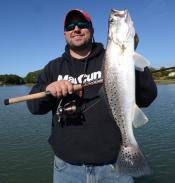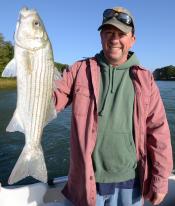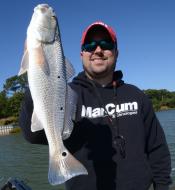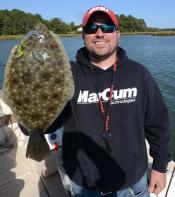 Saltwater fish pull hard. Fact. Sometimes it’s just that simple and easy. My annual saltwater fix was once again satisfied these past few days with some incredible fishing, both in terms of the numbers of species, and the quality of those fish caught. As it is with much of life and fishing inshore tidal water-ways, the more you know, the more you realize how much you don’t know. Tides throw a curveball into the equation, as do weather conditions, and once you start putting together the formula for fishing success out there, you realize that it’s not an easy one to solve. Having some time on the water to fall back on, along with the benefit of some pretty spectacular conditions, we were lucky fishermen in more ways than one. We tried out that very luck in several of the many tidal inshore creeks that flow into either the Chesapeake Bay side of Virginia’s Eastern Shore, or the Atlantic Ocean (sea-side). As always, tidal flow and currents dictate much of the pattern. Where you can drive the boat, the specific areas you target, the species you expect to catch and where; all are inexorably linked to the tide. Rising? Falling? Flat calm? Are you at the head of the creek system where it flows hardest first, or the mouth of the creek where it empties last? Is there a strong wind stacking water on one end of the creek, such that it pours harder on a falling tide on one-side of the river or other? These minute details were key to our approach.
Saltwater fish pull hard. Fact. Sometimes it’s just that simple and easy. My annual saltwater fix was once again satisfied these past few days with some incredible fishing, both in terms of the numbers of species, and the quality of those fish caught. As it is with much of life and fishing inshore tidal water-ways, the more you know, the more you realize how much you don’t know. Tides throw a curveball into the equation, as do weather conditions, and once you start putting together the formula for fishing success out there, you realize that it’s not an easy one to solve. Having some time on the water to fall back on, along with the benefit of some pretty spectacular conditions, we were lucky fishermen in more ways than one. We tried out that very luck in several of the many tidal inshore creeks that flow into either the Chesapeake Bay side of Virginia’s Eastern Shore, or the Atlantic Ocean (sea-side). As always, tidal flow and currents dictate much of the pattern. Where you can drive the boat, the specific areas you target, the species you expect to catch and where; all are inexorably linked to the tide. Rising? Falling? Flat calm? Are you at the head of the creek system where it flows hardest first, or the mouth of the creek where it empties last? Is there a strong wind stacking water on one end of the creek, such that it pours harder on a falling tide on one-side of the river or other? These minute details were key to our approach.
 River-fisherman, you’d love this stuff. Much of what we focused on were areas where the tide was creating strong current breaks, thus concentrating fish movements. Natural islands, sea-walls, small braided channels in a sand flat; all were areas that held good numbers of fish, but only when the tide was either quickly rising or more-often, falling…and just like on the river, the way the current swept your bait, and how naturally you presented it, heavily influenced your catch-rate. It’s probably no surprise that our tactic of choice was pitching B’Fish’n Precision jigs with various plastic offerings. There’s something about the way a jig sweeps in current, that gets you bit. For this application, their stamped weights (sizes) on the back of the jig allows you to effortlessly fine tune your jig weight to the strength of the tide, all in 1/16oz increments. The wire plastic keeper on the hook keeps those baits where they need to be, amidst crabs, croaker, and all kinds of other sea creatures that would otherwise wreak havoc with your presentation. The ringworms we used had a great deal to do with our success too. Firecracker chartreuse tail, and Stewarts Pro Blue being the best for both numbers AND big fish, the latter bait of which I got a tip from James on. He had mentioned that it was a big seller out east, probably because of how well it mimics the eels that are a favorite prey species of many of the sportfish out there.
River-fisherman, you’d love this stuff. Much of what we focused on were areas where the tide was creating strong current breaks, thus concentrating fish movements. Natural islands, sea-walls, small braided channels in a sand flat; all were areas that held good numbers of fish, but only when the tide was either quickly rising or more-often, falling…and just like on the river, the way the current swept your bait, and how naturally you presented it, heavily influenced your catch-rate. It’s probably no surprise that our tactic of choice was pitching B’Fish’n Precision jigs with various plastic offerings. There’s something about the way a jig sweeps in current, that gets you bit. For this application, their stamped weights (sizes) on the back of the jig allows you to effortlessly fine tune your jig weight to the strength of the tide, all in 1/16oz increments. The wire plastic keeper on the hook keeps those baits where they need to be, amidst crabs, croaker, and all kinds of other sea creatures that would otherwise wreak havoc with your presentation. The ringworms we used had a great deal to do with our success too. Firecracker chartreuse tail, and Stewarts Pro Blue being the best for both numbers AND big fish, the latter bait of which I got a tip from James on. He had mentioned that it was a big seller out east, probably because of how well it mimics the eels that are a favorite prey species of many of the sportfish out there.
 Hardbaits worked also, but jigs stole the show. Rapala X-raps and Clackin’ Minnows all took fish, but the subtle touch of a jig/plastic combination was what took the bulk of all species. Red drum (redfish or channel bass) made up a much larger percentage of the catch than in recent years, and these things fight! The bite is more of a pick-up-and-run instead of a “thump,” but once hooked, you know what you’ve got. The same could be said for the striped bass (stripers, rockfish, etc.). We found good numbers of them, especially in the heavy current areas where they awaited all kinds of goodies being swept out from the tide. Speckled trout were our primary species of target, and we really got into them the last day of our trip. Moving water was key here, and we actually did better on a rising tide for this species. Different from the other species, they tattoo the bait, leaving no question as to whether or not you should set the hook. Also different than the rest, I believe they’re second perhaps only to flounder amongst the fish we decided to eat.
Hardbaits worked also, but jigs stole the show. Rapala X-raps and Clackin’ Minnows all took fish, but the subtle touch of a jig/plastic combination was what took the bulk of all species. Red drum (redfish or channel bass) made up a much larger percentage of the catch than in recent years, and these things fight! The bite is more of a pick-up-and-run instead of a “thump,” but once hooked, you know what you’ve got. The same could be said for the striped bass (stripers, rockfish, etc.). We found good numbers of them, especially in the heavy current areas where they awaited all kinds of goodies being swept out from the tide. Speckled trout were our primary species of target, and we really got into them the last day of our trip. Moving water was key here, and we actually did better on a rising tide for this species. Different from the other species, they tattoo the bait, leaving no question as to whether or not you should set the hook. Also different than the rest, I believe they’re second perhaps only to flounder amongst the fish we decided to eat.
 With this being what’s looking more like an annual trip, I decided to invest in some better rods to stay out there. It’s a commitment, but the difference it made in our fishing was directly noticeable. Both in terms of the amount of fish caught, but also in the size. A special thanks goes out to Dean Marshall from Angler’s Guide HQ for helping me select the rods online here. Dean took stock of what we were doing, and recommended a few St. Croix Inshore Avid rods that were, well, perfect for what we were doing. Getting them drop-shipped to where we stay for no additional cost, and helping to pick out the right rods made all the difference in the world in fishing these fish. Given his personal success as a river fisherman, and the parallels the tide-factor brings, it’s no surprise.
With this being what’s looking more like an annual trip, I decided to invest in some better rods to stay out there. It’s a commitment, but the difference it made in our fishing was directly noticeable. Both in terms of the amount of fish caught, but also in the size. A special thanks goes out to Dean Marshall from Angler’s Guide HQ for helping me select the rods online here. Dean took stock of what we were doing, and recommended a few St. Croix Inshore Avid rods that were, well, perfect for what we were doing. Getting them drop-shipped to where we stay for no additional cost, and helping to pick out the right rods made all the difference in the world in fishing these fish. Given his personal success as a river fisherman, and the parallels the tide-factor brings, it’s no surprise.
Of course we ate every kind of seafood from blue crab, oysters, scallops, shrimp, and flounder…..all while telling far too many stories, enjoying every bit of doing it. Better fishing, more quality fish, and some phenomenal weather really made the trip a success.
Joel
Some more photos.
Looks like a blast Joel. Do the Flounder eyes move to the top of the body like a Halibut?
Pretty sure they do, though I can’t remember looking that closely. Very weird, but a very cool fish. Get them topside and they slap the water like a beaver’s tail in fast-forward.
Joel
BfishN Tackle Sour Apple would have given you larger fish.
Looks like a hoot Mr. Nelson!
Nice report Joel!
We don’t get to see many salt water reports here on IDO.
Unfortunate because it sure is fun reading and dreaming about going on a trip of this nature.
Thanks for sharing!
Looks like a blast Joel! You’re getting me excited to head back down to Fla and catch some specs this winter.
Were you primarily fishing out of a boat or were you able to catch them shore fishing as well?
That was one of the few fish we caught with twin fangs, which is what I was trying to show, but will bring Sour Apple next year anyway!
All of the fish over 15″es or so seemed to have one or both of them missing for whatever reason?
Joel
Will – The tidal creeks we were fishing just had so many tidal changes. With a number of the locations we fished, I’m sure we could’ve done quite well from shore, but only for a short period – say 30 mins or so.
The premium next year will be to fish at the head of the creeks and move our way down as the tide flows from top to bottom, hitting milk-run money spots as we work our way out to the mouth of the bay or the ocean.
I feel like this will provide us with more fish. That said, this was the best year of each of the 3 I’ve been out there, both in terms of size of fish and overall numbers of species. We caught fewer fish than in previous outings, but there were far more quality fish this year.
Joel